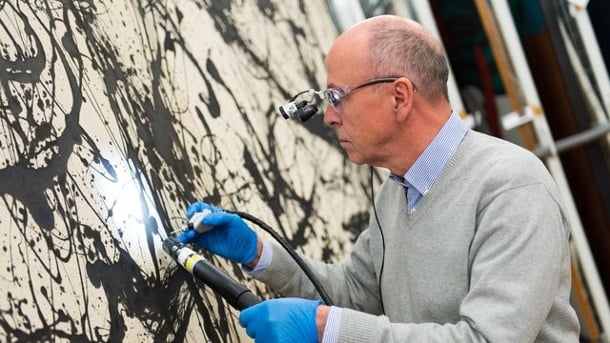
Ever wondered how museums maintain their collections of pricelss art? The restoration and conservation of artworks for future generations is one of the primary functions of contemporary cultural institutions. Thus, the cleaning of artworks has developed into a science, with restorers inventing an array of fascinating and unusual techniques to keep masterpieces in the condition in which the artists had intended them to be viewed.
At the Kunstsammlung Nordrhein-Westfalen, in the German city of Düsseldorf, director of restoration Otto Hubacek is currently in the process of cleaning Jackson Pollock’s Number 32 (1950), and has come up with an innovative method for the legendary painting.
Jackson Pollock Number 32
Photo: Kunstsammlung Nordrhein-Westfalen, Düsseldorf
The painting is considered one of the most important examples of American abstract expressionism. But after 65 years, its surface has gradually degraded into a yellowish-gray color. “We have not taken the decision lightly” director Marion Ackermann told Süddeutsche Zeitung, “Our Pollock is so sacred.”
Cleaning the large scale 2.69m x 4.57m surface with a tiny brush and microfiber sponge was not an option for Hubacek.
After months of research and consultation with international colleagues, the art restorer developed his own technique, whereby a special device he had designed blasts particles of wheat starch onto the canvas. He must then carefully removes the starch with a miniature brush attached to a vacuum cleaner.
Restorers found boot prints and coffee stains on Pollock’s canvas.
Photo: theuntappedsource.com
The catch is that he must avoid hitting the black paint, as the wheat starch could affect it. The painstaking process requires extreme caution and would take between 200 to 300 hours to complete.
Hubacek now plans to present the results of his unusual restoration technique to the Museum of Modern Art in New York.
According to DW, the restorer has also gained some unusual insights into Pollock’s creative process. During his analysis of the artwork, Hubacek discovered footprints and even coffee stains on the surface. However, he insists, “The coffee stains belong to the work,” and has vowed not to remove them.
Meanwhile in Berlin, visitors to the Deutsche Bank KunstHalle can see what the results of a successful restoration look like in person. Arguably Pollock’s most important work Mural (1943) has gone on display in the German capital fresh from the restoration workshop.